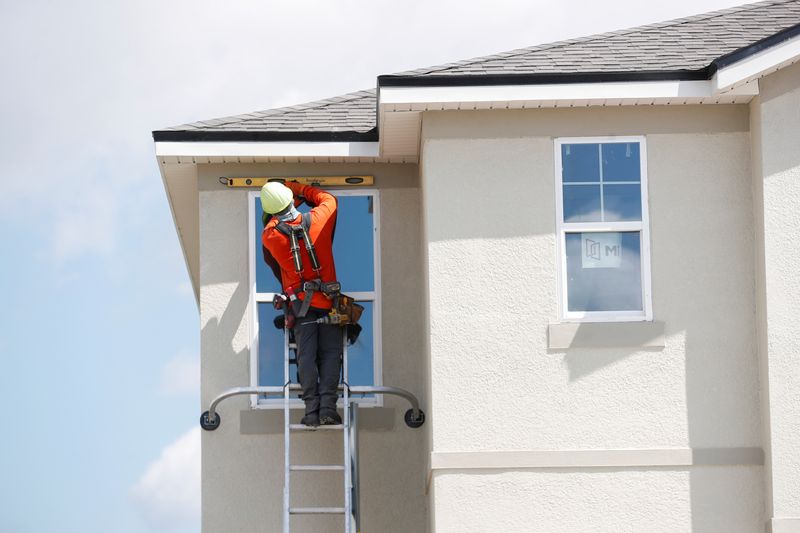By Lucia Mutikani
WASHINGTON (Reuters) - U.S. single-family homebuilding surged to more than a 1-1/2-year high in November and could gain further momentum, with declining mortgage rates and incentives from builders likely to draw potential buyers back into the housing market.
The report from the Commerce Department on Tuesday also showed permits for future construction of single-family housing last month increased to the highest level since May 2022. A jump in mortgage rates had dampened new construction activity in recent months. The new housing market remains underpinned by an acute shortage of previously owned homes available for sale.
Economists raised their fourth-quarter gross domestic product growth estimates, and predicted that the housing market would help the economy avoid a recession next year.
"American housing demand is permanently higher than before the pandemic since people are spending more time at home," said Bill Adams, chief economist at Comerica (NYSE:CMA) Bank in Dallas. "As long-term interest rates fall, builders will add more supply to the housing market to meet that demand, fueling economic growth."
Single-family housing starts, which account for the bulk of homebuilding, jumped 18.0% to a seasonally adjusted annual rate of 1.143 million units last month, the Commerce Department's Census Bureau said. That was the highest level since April 2022.
Activity was also likely supported by mild temperatures and dry conditions. Data for October was revised slightly lower to show single-family starts rising to a rate of 969,000 units instead of the previously reported 970,000 units. Starts vaulted 42.2% on a year-on-year basis in November.
Single-family homebuilding soared in the Northeast, Midwest and the densely populated South. It declined in the West.
The rate on the popular 30-year fixed mortgage averaged 6.95% last week, the lowest level since August, from 7.03% in the prior week, according to data from mortgage finance agency Freddie Mac. It has tumbled from a 23-year high of 7.79% in late October, tracking the decline in U.S. Treasury yields.
The Federal Reserve held interest rates steady last week and policymakers signaled in new economic projections that the historic tightening of monetary policy engineered over the last two years is at an end and lower borrowing costs are coming in 2024.
A survey on Monday showed confidence among single-family builders rebounded from an 11-month low in December. The National Association of Home Builders noted that "many builders continue to reduce home prices to boost sales."
Stocks on Wall Street were trading higher. The dollar fell against a basket of currencies. U.S. Treasury prices rose.
BUILDING PERMITS RISE
Permits for future construction of single-family homes increased 0.7% to a pace of 976,000 units last month, the highest in 1-1/2 years. The strength in housing starts and permits bodes well for residential investment, which rebounded in the third quarter after nine straight quarterly decreases.
Economists at Goldman Sachs raised their fourth-quarter GDP growth estimate to a 1.7% annualized rate from a 1.5% pace. The economy grew at a 5.2% rate in the third quarter. The anticipated slowdown in growth this quarter is likely to reflect moderate consumer spending as well as drags from inventories and a wider trade deficit.
Starts for housing projects with five units or more rose 8.9% to a rate of 404,000 units in November. Activity is, however, moderating as builders work through a large stock of apartment buildings under construction.
Demand for rental accommodation is also cooling, with the rental vacancy rate rising to more than a two-year high in the third quarter. Increased supply of rental housing is one of the main factors expected to drive inflation lower next year.
Multi-family building permits dropped 9.6% to a rate of 435,000 units last month.
Overall housing starts soared 14.8% to a rate of 1.560 million units in November. Economists polled by Reuters had forecast starts would fall to a rate of 1.360 million units from the previously reported 1.372 million units.
Building permits as a whole fell 2.5% to a rate of 1.460 million units last month.
The number of houses approved for construction that are yet to be started fell 2.5% to 276,000 units. The single-family homebuilding backlog dropped 4.2% to 136,000 units, the lowest level since May. The completions rate for that housing segment declined 3.2% to 960,000 units.
Overall housing completions rose 5.0% to a rate of 1.447 million units. According to the National Association of Realtors, the inventory of previously owned homes on the market is just above 1 million units, well below nearly 2 million units before the COVID-19 pandemic.
Realtors estimate that housing starts and completion rates need to be in a range of 1.5 million to 1.6 million units per month to bridge the inventory gap.
The number of housing units under construction rose 0.7% to a rate of 1.685 million. The inventory of single-family housing under construction increased 1.9% to a rate of 680,000 units.

The stock of multi-family housing under construction dipped 0.1% to 988,000 units, not far from recent record highs.
"The drag on GDP from weak residential investment is starting to diminish," said Jay Hawkins (NASDAQ:HWKN), a senior economist at BMO Capital Markets in Toronto. "However, it will take some time to balance supply and demand and improve affordability."